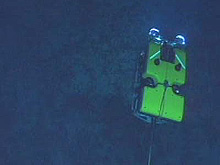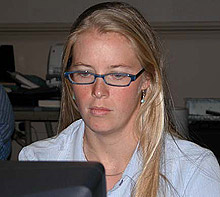
Kristin Ludwig, Geologist and University of Washington PhD student.
Diving Deep- Remotely
July 24 AM, 2005
Kristin Ludwig
Geologist
University of Washington PhD student
![]() Scientist
watch with excitement as Hercules is prepared for it's first science
mission to the Western Massif (Quicktime, 864 Kb)
Scientist
watch with excitement as Hercules is prepared for it's first science
mission to the Western Massif (Quicktime, 864 Kb)
It is half past midnight- Pacific time. In the mid-Atlantic, the sun is probably just rising. It is 0630 on board the NOAA ship Ronald H. Brown. However, all of our data are logged according to GMT time, which is an hour ahead of the Brown - 0730. I am slowly becoming accustomed to thinking in three time zones.
That's been just one of the challenges of preparing for the first day of diving with IFE ROV Hercules.
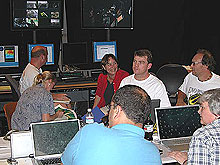
Scientists take their stations in UW's Science Control Center. Click image for larger view and image credit.
Today has been a whirlwind of learning curves, troubleshooting, and anticipation. We have all spent much time negotiating maps in different coordinate systems, computers on different servers, and coordinating with colleagues, engineers, and production crew at three hubs of communication and expedition activity. We have used telephones, cell phones, satellite links, live feed from video cameras, internet, and email to communicate across the thousands of miles that separate us from our colleagues at UNH, URI, and the Ronald H Brown. To say the least, it's been a little busy around here.
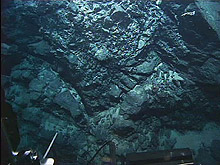
The Hercules arrives at the seafloor and the first images arrive live on the ship. Less than 1 second later the live images arrive at University of Rhode Island (URI), University of New Hampshire (UNH) and University of Washington (UW). Click image for larger view and image credit.
But things are falling into place. As I write, Hercules is imaging the seafloor of the western Massif - terrain that has never been previously explored. These images are streaming on the internet - it's like having our own Mars rover to explore the seafloor from the comfort of Seattle.
Over the course of several days, our classroom on the UW campus has been transformed into a control van -complete with plenty of laptops, mapping tools, snacks, espresso, music, and mascots- all things that you would find on any shipboard control van. The only difference is that we don't have to worry about securing equipment for high seas - and a bell rings on the hour to mark the beginning and end of weekday classes.
There has been so much anticipation the last several days (even weeks and months!) of this project and an immense amount of planning and teamwork has gone into making this program happen. While we all have confidence in our collective skills, expertise, and technology, we still have been crossing our fingers that this would all somehow magically work- and just maybe, we would be able to simultaneously see the Atlantic seafloor from three separate locations around the world.
With so much anticipation, we all held our breaths for Hercules' first dive. She slipped gracefully into the water. The live feed from the high definition video showed seawater sloshing around her camera lenses as she dipped below the surface and began her dive. It was really happening! We impatiently waited the two hours for the descent to ~2200 m depth on the south face of the Massif. Eventually, the altimeter started to flicker and pick up a signal around 35 m off the bottom. The sonar image changed colors with a bright magenta signal indicating a solid rock face in front of the vehicle. The seafloor then loomed into view out of the deep blue- and Argus illuminated Hercules on the face of a sheer cliff of talus. A collective "wow!" came from around the control room. We were all impressed with the image- several people at UW, UNH, and on the ship mutually exclaimed via intercom, "can you just imagine what this is going to be like at Lost City?!! This is going to be absolutely incredible!"
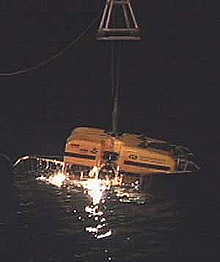
IFE ROV Hercules is lifted from the deck of the ship and begins the descent to the seafloor of the Western Massif. Image courtesy IFE,URI-IAO, UW Lost City science party and NOAA.
Finally, our group of well-seasoned sea-going oceanographers was convinced that this leap of technology could not only successfully work, but that it would also be fun. A few days ago, it was surreal to be able to talk to the ship via a long distance phone call with barely a delay. Tonight, it is even more surreal to see the dramatic live image of Hercules probing the seafloor in a pool of light cast by Argus.
During this first dive, we have already collected three rock samples and have observed huge rock outcrops, sedimented areas with ripple marks made by deep currents, sponges, shrimp, and a gulper fish from our now quiet control room in Seattle. It is almost like we are at sea.
After a burrito run for dinner, we changed shifts and relaxed into our watch stations to enjoy our first experience diving "remotely" from our control room in Seattle. Hopefully tomorrow night we will be exploring the spires of Lost City through the eyes of Hercules and Argus. Lost City, here we come!
Sign up for the Ocean Explorer E-mail Update List.



























